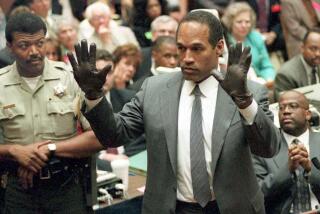Cult ‘clones’ a baby! Read (and read) all about it
- Share via
Journalistic fairness, as Edward R. Murrow once remarked, “is the willingness to give the word of Judas equal weight with that of Jesus.”
It is an austere, bracingly astringent ethic, that in the overwhelming majority of cases has served the American media very well. But when it is too casually applied -- as when a story fails to identify adequately either the betrayer or the victim -- the result isn’t pretty and it isn’t fair.
In fact, the most attenuated applications of this sort of faux fairness produce journalism that any levelheaded reader or viewer is entitled to adjudge absurd.
Take, for example, the coverage given last Friday’s assertion by the Raelian religious cult that a company founded by its adherents had cloned the first human baby. Consider, for one moment, the objective circumstances: a crackpot cult, whose French founder says he got his marching orders from a space alien, calls a press conference in Miami to announce that a cloned child has been born to an unidentified woman in an unspecified place the day after Christmas. Proof, according to the company’s CEO -- a chemist named Brigitte Boisselier -- will be forthcoming in nine days --not 10, not eight, but nine.
Now let’s see, here we have a bunch of kooks who operate a Canadian theme park called UFOland, whose leader, Claude Vorilhon -- also doing business as Rael -- is a former sportswriter who has boasted in print of his ability to generate free publicity. You have a press conference in the sort of warm, glitzy city where journalists like to gather at this time of year. (Ever notice the paucity of midwinter datelines from Bismarck, N.D.?) You have an “announcement” in the midst of the year’s slowest news cycle, one that just happens to be associated with an international nativity festival.
What a coincidence.
And what does it provoke? Irritated shrugs or amused chuckles? Perhaps suggestions that Vorilhon and Boisselier stop bothering people until they’ve had Barry Scheck take a look at the DNA tests?
Sadly, none of the above. The result was an international media frenzy. And while the majority of serious newspapers in the United States, including the Los Angeles Times and New York Times, kept the story off their front pages, dozens of others did not. Moreover, reams of weekend analyses and interviews followed. Worse, what was missing from nearly all the first day’s news stories was the context that would have allowed readers to weigh the import of the information being put before them.
In its place were two or three paragraphs of boilerplate prose, blandly noting that Vorilhon founded his cult in 1973 after he said he met a diminutive bearded alien atop a French mountain where he had gone walking while playing hooky from his magazine job. The alien told him that.... Actually, there’s no reason to go into this stuff.
The point is that this is journalistic sloth masquerading as fairness. The mere recitation of Vorilhon’s preposterous story tells readers nothing useful about the Raelians or their dubious prophet. A quick look at the published record would have -- though it also would have diminished the story’s attractiveness.
Earlier last year, for example, Times staff writer Aaron Zitner went to Valcourt, Canada, where the sect is headquartered. In his 2,000-word report, he wrote: “Who is Claude Vorilhon, and what is his true goal? A close look at the Raelians shows a long history of publicity stunts, and the cloning effort may be one more.” Zitner also reported on the sect’s recruitment of beautiful female “Angels” committed to sleeping only with returning aliens or their human prophets.
The Times story quoted a book in which Vorilhon bragged that his company’s founding had “for a minimal investment ... got us media coverage worth $15 million. I am still laughing.” But, as Zitner reported, others weren’t laughing, including the grieving West Virginia couple from whom Vorilhon’s followers had extracted a reported $500,000 to set up a bogus laboratory in which their dead infant son was to be cloned.
Similarly, a glance at the Raelians’ multimedia Web site would have turned up instances in which the prophet mused darkly on the influence of U.S. Jewish lobbies on the Mideast peace process; described the U.S. bombing of Hiroshima during World War II as morally identical to the Holocaust and the Sept. 11 terrorist attacks; viciously attacked the Vatican and praised Raelians who, last fall, went into Catholic high schools across Montreal and urged students to burn crucifixes and declare themselves apostate from their faith.
The failure to point out this sort of thing, even in news stories, said Orville Schell, dean of UC Berkeley’s Graduate School of Journalism, sets off a process that is the journalistic equivalent of laundering.
“Usually,” he said, “these really screwball things come in through the tabloid vectors and get on the hard disk of serious media, where they function like journalistic computer viruses. They’re really hard to erase. Something similar now has happened with the Raelians. Now that they’ve established a beachhead on the front pages of so many newspapers, it’s going to be really hard to dislodge them.
“My hometown newspaper, the San Francisco Chronicle, splashed this thing across their front page like scrambled eggs,” he said.
John Curley, the Chronicle’s deputy managing editor who made the decision, said, “We were very aware that the Los Angeles Times, the New York Times and the Washington Post would not deign to put this story on their front pages. But we saw it was getting amazing media coverage elsewhere, including on CNN, which filled its afternoon broadcasts with it. It was out there in the public’s consciousness. What we saw in the reaction of the national papers was the media’s self-absorption, its tendency to believe that putting a story like this on the front page gives it a prominence and credibility it otherwise wouldn’t have and doesn’t deserve. We elected to put it on our front page precisely so we could write a story that was scientifically accurate but skeptical, one that characterized this as a dubious claim.”
Schell acknowledged, “It can be quite hard to know how to treat a story of this sort, which has elements of new technology and what you might loosely call an unconventional source. But I think that in the best of all possible journalistic worlds, the responsible media’s coverage would start when these people actually produce a credible analysis of the baby’s DNA.”
The problem is further exacerbated, Schell said, by the Raelians’ religious status. “We in the media never quite know how to handle religion as a story. It’s an incredibly loaded but important topic. As bad a job as we do covering traditional religions as institutions, we do even worse when it comes to treating belief. In the Raelians, you’ve got a strange marriage of belief and public relations, and when you add in sex, cloned babies and flying saucers, you get a story that is lamentable, but obviously irresistible to a lot of journalists.”
Failure to resist that temptation -- to hide behind a faux fairness -- has its long-term consequences, according to Schell.
“The question of whether to run this story on your front page or evening newscast was a test of virtue for the media,” he said. “When so many people failed it, as they did, everybody associated with the media became a little less dignified. This story is a very obvious example of a larger, more worrisome problem, which is that there are a thousand ways every day in which the contemporary media doesn’t know how to make the dignified decision.
“Indignity by a thousand cuts seems to be our fate these days, and it leaves a lot of us feeling sorry about the enterprise.”


